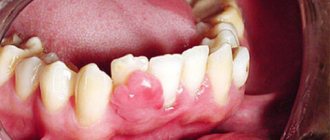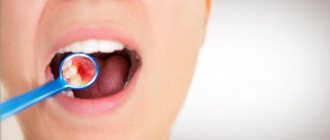A child's tongue that is very large or very thick is called macroglossia. This pathology is caused by structural abnormalities on the surface or inside the organ. Most often, this pathology appears in children. The diagnosis of macroglossia is made by a doctor when the child’s tongue is completely enlarged or certain areas of it are swollen. This disease can be congenital or acquired.
What does tongue position affect?
Language takes part in many important processes:
- determines the taste and temperature of food;
- helps in mixing food and saliva, starting the digestion process;
- facilitates swallowing;
- participates in the formation of speech.
And also, making several thousand movements per day (swallowing movements alone are about 2000), the tongue participates in the formation of the arch of the palate and bite.
The relationship of the jaws in the bite has a close relationship with the position of the head relative to the body and posture in general.
Bite is the relationship between the dentition of the upper and lower jaws during their tight closure. Depending on age, the bite can be milky, replaceable or permanent. Classification of occlusion is not the topic of this article, so I will focus only on the description of physiological occlusion, which is characterized by the following features:
- does not interfere with the process of eating;
- does not distort speech;
- does not spoil the external characteristics of the face.
When the teeth are completely closed, the physiological occlusion meets the following indicators:
- the upper dentition covers a third of the lower dentition;
- all opposing chewing teeth of the upper and lower jaws fit well together;
- a conventional central line drawn vertically along the face divides the jaws into equal halves.
I apologize in advance to orthodontists for such a simplified description of the physiological bite and there may be some other inaccuracies. I hope the meaning of the article did not suffer from this.
For proper growth of teeth, the so-called myodynamic balance must be formed in the oral cavity, that is, the pressure of the tongue from the inside on the dentition of the upper jaw must correspond to the pressure of the muscles of the lips and cheeks from the outside.
Normally, the tip of the tongue is in a neutral position, located behind the upper incisors, without touching them. Where the tongue is when we pronounce the sound “H” is the so-called “resting point”. During each swallowing movement, the back of the tongue is pressed against the palate, stimulating the growth of the upper jaw in width, improving blood supply to the nasal and oropharynx and thus increasing local immunity. The correct position of the tongue at rest and when swallowing is only possible with nasal breathing, while the mouth must be closed. When breathing through the nose, all the air inhaled has time to be purified and warmed up. The air flow passing through the nasal turbinates also stimulates the growth of the upper jaw in width and the harmonious growth of the entire middle third of the face.
Now I will dwell a little on the changeable bite and the problems of the formation of a physiological bite, which become obvious precisely during the change of teeth. Usually this age ranges from 4-5 years to 12-14 years. During the mixed bite, the most intensive growth of the jaw bones occurs, so bite correction is also most effective at this time.
In children who breathe through their mouth, the so-called “adenoid” type of face is formed, the face becomes narrow and long - elongated. Narrow jaws cause a lack of space for permanent teeth, that is, they are crowded. The Gothic palate and lack of space for the back of the tongue creates problems with sound pronunciation.
Children with malocclusion often breathe through their mouths, even if the nasal passages are clear. They develop habitual mouth breathing and begin to get colds more often. It has been proven that mouth breathing reduces blood oxygenation, as well as the transfer of oxygen to tissues. The brain suffers more than other organs from hypoxia. Children become irritable, not assiduous, and not attentive.
The tongue in such children is in the middle (interdental) or low position - between the palate and the lower jaw. When swallowing, it does not rest against the roof of the mouth, but against the teeth. The tongue is a powerful muscular organ and when it is pressed, the teeth deviate from their normal position.
Very often this is combined with weakness of the orbicularis oris muscle, which normally should balance the pressure on the teeth from the outside.
Normally, swallowing should be visible only by the movement of the thyroid cartilage, the face should not tense. If the position of the tongue is incorrect and the orbicularis oris muscle is weak, the child has to use additional muscles to keep the mouth closed when swallowing. He begins to help himself when swallowing with the corners of his lips, facial muscles, neck movements, shoulders, and sometimes even his stomach.
The tongue, in the middle or lower position, blocks the airways and, in order to somehow open them, the child is forced to move his head forward and raise his chin. This unnatural position of the head and neck also changes the upper chest. Orthopedists, seeing such a picture, talk about poor posture.
So, a change in the position of the tongue leads to a change in the position of the head, a distortion of the anatomically correct location relative to each other of the cervical vertebrae, hyoid bone, cartilage of the larynx and soft tissues of the neck, trachea and esophagus, vessels supplying the brain, and nerve trunks that ensure the functioning of all internal organs.
Thus, during a mixed dentition, it becomes extremely important to form nasal breathing and create conditions for the anatomically correct position and functioning of the tongue, because this will contribute to both the normal development of the dentofacial system and the child’s entire body.
- normal chewing, facilitates the functioning of the entire gastrointestinal tract;
- normal swallowing forms a correct bite and harmonious facial features;
- nasal breathing reduces the risk of colds (the air is purified, warmed, lymphoid tissue is not subject to additional stress and does not hypertrophy);
- improves central nervous system function due to sufficient oxygen supply;
- communication function improves due to clear and understandable speech;
- Due to correct posture, a sense of balance, dexterity, and coordination develops.
Correct bite and anatomical position of the tongue are the key to the health and well-being of your child.
I would like to briefly list the factors that can lead to incorrect position and functioning of the tongue:
- Intrauterine factors (multiple pregnancy, abnormalities in the structure of the uterus, increased tone of the uterus during pregnancy, genetic conditions, etc.);
- Traumatic childbirth;
- Prematurity;
- Artificial ventilation in the first year of life;
- Artificial feeding;
- Untimely introduction of complementary foods;
- Lack of solid food in the child’s diet;
- Bad habits: thumb, tongue, cheek, and various objects sucking, prolonged pacifier sucking (more than 1.5 years);
- Premature loss of baby teeth;
- Frequent diseases of the ENT organs, enlarged adenoids.
How to determine the presence of macroglossitis
Doctors divide macroglossitis into two types: false and true. False is associated with abnormal development of the jaw. A narrow, sunken jaw does not indicate true macroglossitis, and is the result of abnormal bone development.
Beckwith-Wiedemann syndrome - abnormally large tongue
With true macroglossitis, the tongue is too large, its size exceeds the norm by 1.5–3 times.
Other signs are also observed:
- the mouth does not close, the muscular organ is protruded;
- increased salivation, drooling;
- the skin in the mouth and chin is irritated;
- teeth marks are visible on the tongue;
- the thick tongue is covered with erosions, ulcers along with the inner surface of the cheeks;
- malocclusion;
- labored breathing;
- difficulty chewing and swallowing food;
- Because of the very large tongue, it is difficult for the patient to speak and it is difficult to understand his speech.
A well-known case of macroglossia - a woman’s tongue grew throughout her life
What parents should pay attention to and be wary of
- Breathing through the mouth if the child does not have a runny nose.
- No gaps between teeth by 4-5 years.
Baby teeth are small and there is usually always room for them, even if the jaw has not developed enough. As the child grows up and prepares for a mixed dentition, so-called trema should appear between the baby teeth - small but distinct distances. When baby teeth fall out, permanent teeth will erupt, which are much wider than baby teeth, and they should have enough space for normal growth and the formation of an even, beautiful dentition.
- Observe the child’s swallowing of saliva; normally, swallowing occurs imperceptibly, without tension in the facial muscles.
Usually, during an appointment, a pediatric dentist draws the attention of parents to the emerging problems of forming a correct bite and refers such children to an orthodontist.
If this does not happen, it is necessary to show the child at the age of 4-5 years to a pediatric orthodontist, preferably one who takes into account the functional approach in his work.
Complications and consequences
It is very important to recognize the disease at the initial stages of development. This will allow you to complete the course of treatment and prevent the development of dangerous consequences. In general, macroglossia does not greatly worsen the patient’s life, but often becomes the cause of various diseases. Children with this diagnosis become outcasts and do not experience normal socialization. Speech is slurred, there is a defect in appearance, so it is not easy for them to communicate with peers. Typically, children prefer to avoid a child with this pathology. The child grows up with complexes, inferior, and withdraws into himself.
A secondary disease that develops against the background of macroglossia is the proliferation of connective tissues of the tongue. In the presence of pathology, other diseases become more active:
- Dysfunctions in the respiratory system. Since a very large tongue prevents full breathing through the nose, the child gets used to breathing through the mouth.
- Difficulty pronouncing sounds. It is not easy to pronounce words; whistling and hissing sounds are not pronounced at all.
- Curvature of teeth.
- Oral diseases.
- Since food is not fully chewed, various problems with the digestive system arise - gastritis, colitis, ulcers.
- The tongue is constantly dry, painful, and erosions or ulcers often appear on its surface.
How to correct malocclusion and tongue position.
There must be an integrated approach. Modern orthodontics offers various ways to straighten teeth. But as we have already seen, straightening teeth is ineffective without eliminating the causes leading to these changes.
Therefore, the solution to the problem of malocclusion should be aimed at the entire complex of pathological changes: restoration of the anatomically correct position of the tongue, development of the correct stereotype of swallowing, chewing, head position, posture.
Osteopathic treatment offers exactly this approach: restoration or formation of the correct relationship of anatomical structures
- Correction of weakened or excessively tense muscles of the face, neck, floor of the mouth and the tongue itself, this will lead to the restoration of the correct position of the tongue in the oral cavity and uniform participation of the corresponding muscle chains in the processes of chewing and swallowing.
- The effect on the bone structures that form the cavities of the nose and mouth leads to the restoration of the physiological volumes of these cavities and helps improve nasal breathing, chewing, swallowing and speech.
- Motor innervation of the tongue, swallowing and chewing is provided by the hypoglossal nerve, which exits the cranial cavity through the canal of the hypoglossal nerve, where in some cases it may be compressed. Until a certain age, mobility is maintained in this zone and using osteopathic methods it is possible to restore the physiological correspondence of these anatomical structures.
Reasons for development
Dysarthria is not an independent disease, although often this speech disorder is the main manifestation of various pathologies of the central nervous system. In most cases (up to 85%), dysarthria accompanies cerebral palsy. Malformations of the nervous system can be caused by a variety of reasons:
- pathological conditions of the fetus during intrauterine development. These include severe toxicosis and the pathological course of pregnancy, chronic maternal diseases and intrauterine infections, hypoxia, asphyxia or ischemia of the fetal brain, Rh conflict, etc.;
- genetic predisposition (presence of severe hereditary pathologies);
- head injuries and illnesses suffered by a child in the first few years of life. These include hydrocephalus, meningitis and other neuroinfections, purulent otitis media, as well as poisoning with toxic substances and intoxication due to infectious diseases.
The above reasons lead to damage to the parts of the brain that control movement, the cerebellum, basal ganglia, brain stem, nerve fibers and their connections with muscles.
Manifestations of dysarthria are different, and they depend on which part of the central nervous system is affected.
Treatment of dysarthria
Since dysarthria can be a manifestation of a variety of nervous system disorders, there is no single treatment regimen for this pathology. The child, first of all, should be examined by a neurologist. He also carries out the treatment. Classes with a speech therapist are auxiliary in this case; they are part of a complex of treatment measures, which also includes:
- drug treatment. After making a clinical diagnosis, the neuropathologist determines the order of treatment measures, prescribes medications, etc. All this is carried out taking into account the severity of the underlying neurological disease, as well as the age of the child. It should be remembered that there is no pill for dysarthria . The medications used in therapy eliminate the main symptoms of the pathology and alleviate the condition of the small patient, making him more susceptible to other methods of correction;
- massage. Manual procedures can reduce the severity of muscle paralysis;
- breathing exercises. Dysarthric children often experience difficulties with speech breathing. Special exercises help them learn to control the exhaled flow, which allows them to normalize the tempo and rhythm of speech;
- physiotherapy.
If you notice symptoms of dysarthria in your child, you should contact a specialist as soon as possible. The sooner doctors and speech therapists begin to deal with dysarthric, the higher the chance of normalizing speech and avoiding difficulties with learning at school.
Even a mild form of dysarthria requires correction, primarily due to the fact that the child himself feels constrained. He is aware of the mistakes in his speech and is offended when others do not understand him. All this leads to the fact that a dysarthric child withdraws into himself and completely stops communicating with the people around him.
Work to normalize speech should be carried out not just by a speech therapist, but by a speech pathologist with sufficient qualifications and experience. When correcting dysarthria, special speech therapy techniques are used, without knowledge of which it is impossible to help a dysarthric child. And, of course, a speech pathologist must have great patience and endurance, because correction of dysarthria is usually difficult and takes a lot of time. The child may not make contact, refuse to complete the proposed tasks, or perform them incorrectly.
Despite all the efforts of specialists, in some cases the correction does not bring the desired results. The reason for this may be problems in the family. For a child to speak, he must be surrounded with love and care. Parental support is of great importance.










